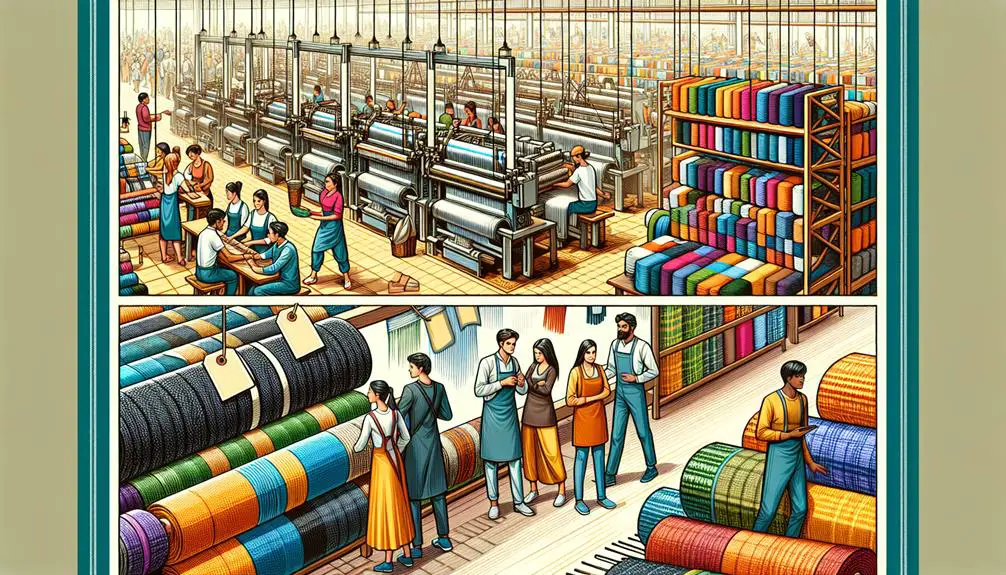I've always been curious about why tweed, a fabric with such a rich history and classic appeal, tends to be more affordable compared to other textiles. It turns out, advancements in production technology and more efficient global supply chains play significant roles. For instance, automated weaving techniques have substantially reduced the labor costs traditionally associated with tweed production. Additionally, changes in trade policies have decreased the tariffs on essential raw materials like wool, which in turn lowers the overall production costs. But there's more to this story—how do these factors affect the quality and perception of tweed in the fashion industry? Let's explore the intricacies behind this intriguing question.
Table of Contents
Key Takeaways
- Advances in automated weaving processes reduce labor costs in tweed production.
- Lower tariffs on wool imports decrease the cost of raw materials.
- Streamlined global supply chains reduce transportation and storage expenses.
- Integration of synthetic fibers with traditional wool lowers material costs.
- Increased efficiency in manufacturing and quality control minimizes waste and errors.
History of Tweed Fabric
Tweed fabric originated in Scotland in the 18th century as a durable solution for the harsh, local weather. Initially crafted by islanders to withstand the chilly, damp climate of the Scottish Highlands, tweed quickly became a staple in rural life. The fabric's natural water resistance and ability to hold in warmth made it ideal for outdoor activities, transforming it from a practical choice to a style icon.
As tweed's popularity grew, its aesthetic evolved with the introduction of iconic patterns such as houndstooth, chevron, and plaid. These patterns not only enhanced the visual appeal of the fabric but also solidified its status in the fashion industry. The distinctiveness of tweed patterns has a rich narrative element, often reflecting the colors and textures of the Scottish landscape.
In the modern era, designer collaborations have played a pivotal role in tweed's evolution. Top fashion designers have reimagined tweed in contemporary ways, integrating it with modern designs while maintaining its heritage qualities. These collaborations have helped keep the fabric relevant and desirable in high fashion circles, ensuring that tweed remains a celebrated material in both traditional and contemporary wardrobes.
Raw Material Cost Analysis
Let's take a closer look at why tweed is so affordable, starting with the raw materials used to make it.
I'll explore how the dynamics of wool supply influence the overall cost, and what factors play a role in production expenses.
Understanding these elements will help us see the bigger picture of tweed's market price.
Wool Supply Dynamics
Understanding the dynamics of wool supply is essential for analyzing why tweed remains an affordable fabric. Recent sheep breeding trends have greatly impacted wool availability. Breeders have optimized their herds to enhance wool yield and quality, ensuring a steady supply of raw materials. This increase in efficiency helps keep the wool costs relatively low.
In addition, changes in import regulations have also played a critical role. By easing restrictions and lowering tariffs on wool imports, countries have facilitated a smoother, more economical flow of this essential resource into markets that produce tweed. These strategic adjustments in both breeding practices and trade policies are key factors in maintaining the affordability of tweed in the global textile market.
Production Cost Factors
Analyzing the cost factors in tweed production reveals that the price of raw materials greatly influences its market affordability. When we dive deeper into what drives these costs, several elements stand out:
- Labor Costs: The craftsmanship required to weave tweed is intensive. Skilled workers are essential, but their wages markedly push up production costs. This aspect can tug at our hearts, knowing that each piece carries the hard work of artisans.
- Energy Efficiency: Tweed manufacturing isn't just about skill; it's also about how energy-efficient the production facilities are. Better energy management means lower costs, which in turn benefits the consumer.
- Quality of Wool: The superior quality of wool, often local, doesn't come cheap, but it ensures durability and comfort. Every thread woven has a story of sustainability and local sourcing, connecting us more deeply to our garments.
Advances in Production Technology
Now, let's talk about how modern technology has made tweed more affordable.
I'll explore how automated weaving processes speed up production, material innovations make it cheaper, and streamlined manufacturing steps reduce waste.
These advancements collectively contribute to lowering the cost of tweed, making it accessible for more people.
Automated Weaving Processes
One key factor driving down the cost of tweed is the adoption of automated weaving processes. This shift has notably reduced labor costs, a major expense in traditional textile production. However, integrating automation also presents challenges, particularly in maintaining the quality that tweed is known for.
Here's how automation impacts the tweed industry emotionally:
- Job Security Concerns: Workers worry about job losses as machines replace manual roles.
- Pride in Craftsmanship: There's a fear that automated processes might dilute the artisanal essence of traditional tweed.
- Consumer Trust: Customers might feel uneasy about the shift, questioning whether automated tweed retains its heritage and quality.
Embracing these changes requires balancing efficiency with preserving the unique legacy of tweed.
Material Innovations
Advancements in material technologies are reshaping tweed production, making it more sustainable and cost-efficient. The introduction of fiber hybridization allows us to blend traditional wool with synthetic or regenerated fibers, enhancing durability while reducing costs. This innovation isn't just about mixing materials; it's about creating a new generation of tweed that maintains the classic aesthetic while being lighter and more adaptable to various climates.
Moreover, the shift toward consumer customization is revolutionizing how we think about tweed. By integrating customer preferences directly into the fiber production phase, manufacturers can produce customized textile batches more efficiently, reducing waste and aligning product offerings more closely with market demand. This tailored approach helps in keeping prices down and satisfaction up, making tweed an accessible luxury.
Streamlined Manufacturing Steps
Building on material innovations, streamlined manufacturing steps in tweed production also play a significant role in reducing costs. The introduction of advanced technologies hasn't only improved labor efficiency but also optimized energy usage.
Here are three key advancements:
- Automated Weaving Machines: These marvels of technology drastically cut down on the manual labor required, accelerating production rates while maintaining consistent quality. This reduction in human effort tugs at our appreciation for both innovation and tradition.
- Energy-Efficient Processes: Modern machinery is designed to consume less energy, which isn't just good for our wallets—it's a nod to our environmental consciousness.
- Integrated Quality Control Systems: These systems minimize waste and errors, ensuring that every yard of tweed meets high standards without the need for costly do-overs. This efficiency resonates with our desire for perfection and respect for resources.
Global Supply Chain Dynamics
The cost of tweed has dropped significantly due to efficiencies in the global supply chain. As I've investigated further into this phenomenon, I've noticed that much of this reduction is tied to evolving trade policies and the adjustment of import tariffs. Countries have negotiated lower tariffs on raw materials like wool, which is essential for tweed production. This reduction in trade barriers directly decreases the cost of importing these materials, allowing manufacturers to produce tweed at a lower cost.
Furthermore, advancements in logistics and technology have streamlined the transportation and tracking of materials across borders. This means that the flow of goods is quicker and more predictable, reducing storage and delay costs, which used to hike up the prices.
Market Demand and Supply
Market demand for tweed has fluctuated, influencing both production rates and pricing strategies. As a lover of timeless fashion, I've noticed that these shifts affect how much I pay for my tweed jackets. Let's dive deeper into what's behind these changes.
Seasonal fluctuations play a substantial role. Tweed, traditionally a winter fabric, sees its demand peak as temperatures drop. Manufacturers often adjust their pricing during these months to maximize profits, but this also means they might lower prices in off-seasons to clear out inventory.
Import tariffs are another key player. Depending on where the tweed is produced and where it's sold, tariffs can have a significant impact on cost. For example, tweed made in the UK but sold in the US might be subject to varying tariff rates, influencing its final retail price.
Here's a breakdown that might tug at your heartstrings:
- The Craftsmanship: Each piece of tweed holds a story of artisan skill and tradition.
- The Heritage: Wearing tweed connects us with a rich history of fashion and culture.
- The Impact: Think about the families and communities behind the fabric, affected by these market shifts.
Understanding these elements helps us appreciate not just the cost, but the value of tweed in our wardrobe.
Competition From Synthetic Fibers
Synthetic fibers are increasingly competing with tweed, offering cheaper and more versatile alternatives. As a fabric enthusiast, I've noticed that these synthetics not only rival the aesthetics of traditional tweed but also enhance user experiences through improved features like synthetic durability. This robustness allows for longer-lasting garments, reducing the need for frequent replacements.
However, it's important to take into account aspects such as consumer allergies. Some individuals find synthetic materials less compatible with their skin, leading to discomfort or allergic reactions. This factor can influence consumer choices, leaning some back towards natural fibers like tweed.
Here's a quick comparison to put things in perspective:
| Feature | Tweed | Synthetic Fibers |
|---|---|---|
| Durability | Moderate | High |
| Allergy-Friendly | Yes | Varies |
| Cost | Higher | Lower |
| Versatility | Limited | Extensive |
Environmental Impact Considerations
As we delve into why tweed is cheap, it's crucial to ponder its environmental impact.
The production of tweed requires significant resources, and the manufacturing processes can lead to pollution. Additionally, these activities might have lasting effects on our ecosystems.
Resource Consumption in Production
Considering the environmental impact, the production of tweed demands significant water and energy resources. It's essential to understand how these resources are used and the broader effects they have. Here's what you need to know:
- Water Usage: Tweed production is water-intensive. From washing raw wool to dyeing fabrics, each step requires large amounts of water. This heavy use can strain local water supplies, affecting communities and ecosystems.
- Energy Efficiency: Manufacturing processes are energy-hungry, primarily using non-renewable sources. This not only contributes to high operational costs but also to larger environmental footprints.
- Resource Depletion: Continuous extraction of natural resources for production leads to depletion, harming ecological balance and biodiversity.
Pollution From Manufacturing Processes
In addition to resource consumption, the tweed manufacturing process also releases pollutants that have a significant impact on air and water quality. These pollutants mainly arise from the dyes and chemicals used to give tweed its distinctive appearance. Proper chemical disposal is critical here; without it, these substances can leach into local waterways, affecting aquatic life and potentially entering the human water supply.
Regulatory compliance is pivotal in mitigating these environmental impacts. Factories must adhere to strict guidelines that govern emission levels and waste management. However, the effectiveness of these regulations often depends on rigorous enforcement and the willingness of manufacturers to invest in cleaner, more sustainable practices. As I've learned, this is an ongoing challenge in the industry.
Long-Term Ecosystem Effects
The long-term ecosystem effects of tweed production are profound, altering habitats and biodiversity for generations. When I explore the intricate details, it becomes clear how our choices impact the world around us.
- Habitat Disruption: Vast areas of natural land are converted into agricultural zones for fiber production, stripping the earth of its native flora and fauna.
- Species Displacement: As habitats are transformed, native species find themselves homeless, unable to compete with new, often non-native species introduced by farming practices.
- Genetic Diversity Loss: The push for monoculture in fiber crops reduces genetic diversity, making ecosystems less resilient to diseases and environmental changes.
It's heart-wrenching to see the ripple effects of such disruptions, urging us to rethink our textile choices.
Fashion Trends Influencing Price
Fashion trends greatly influence tweed pricing, as shifts in popularity can lead to dramatic changes in cost. When high-profile celebrities endorse tweed in their public appearances or social media, it suddenly spikes in demand. This surge often isn't just about more people buying; it's about more people willing to pay a higher price. Celebrity endorsements act as a powerful validation of tweed's value and style, making it more desirable.
Seasonal promotions also play an essential role. Retailers often push tweed more aggressively during fall and winter seasons, aligning with its perception as a warmer fabric. These promotions can temporarily reduce prices to attract buyers, but they also elevate the fabric's profile, keeping it in public view and maintaining a steady interest across other seasons.
Understanding these dynamics is key if you're looking to master the factors that affect tweed's pricing. It's not just about the raw materials or the manufacturing process; it's also about the narrative created around the product through marketing strategies and public endorsements. This knowledge allows you to anticipate price fluctuations and understand why tweed might be cheaper or more expensive at different times of the year.
Consumer Perception of Value
Understanding how consumers value tweed sheds light on its market pricing fluctuations. As a durable and traditional fabric, tweed's perception among consumers directly influences its cost. Effective brand positioning and targeted marketing strategies play pivotal roles in shaping these perceptions.
Here's how consumers' emotions and values impact their view on tweed:
- Nostalgia: Many associate tweed with a bygone era of elegance and tradition. This nostalgic value can evoke a deep emotional connection, making tweed more desirable despite its lower cost.
- Quality Perception: Tweed is often seen as high-quality due to its history and the craftsmanship involved in its production. However, the wide availability due to modern manufacturing techniques might lead some to question its exclusivity and value.
- Sustainability Awareness: With an increasing trend towards sustainable fashion, tweed is valued for its natural fibers and durability. This eco-friendly image is pivotal in contemporary marketing strategies, enhancing consumer appreciation and potentially elevating its market value.
Future Outlook for Tweed Pricing
Looking ahead, tweed pricing may experience shifts due to evolving consumer trends and economic factors. As someone keen on understanding the nuances of the market, I've noticed that these shifts could be greatly influenced by tweed tariffs and upcoming investment opportunities. These elements are pivotal in shaping the market's dynamics.
Here's a quick breakdown of factors that could impact tweed pricing in the near future:
| Factor | Potential Impact |
|---|---|
| Consumer Trends | Increased demand for sustainable and unique textiles could raise prices. |
| Economic Stability | Economic downturns may lower disposable income, reducing demand and prices. |
| Tweed Tariffs | Changes in international trade policies could either increase costs or make tweed more competitive abroad. |
| Investment in Tweed Production | Advances in technology and increased factory output could lower production costs, affecting overall pricing. |
I'm particularly keeping an eye on the tweed tariffs. Changes here could either open up new markets or restrict access, significantly affecting pricing. Meanwhile, investment opportunities in innovative tweed production techniques could also play an important role. By lowering production costs, these investments might make tweed more accessible, potentially stabilizing prices despite other market pressures. It's a dynamic field, and staying informed is key to understanding where tweed pricing might head next.
Frequently Asked Questions
How Do You Properly Care for and Clean Tweed Garments?
To care for tweed, I avoid fabric softeners as they can damage the fibers. I limit dry cleaning to a few times a year and prefer gentle hand-washing to maintain its quality.
Are There Any Famous Personalities Known for Wearing Tweed?
Absolutely, many famous figures have embraced tweed! Icons like Coco Chanel revolutionized women's fashion with tweed suits, and Sherlock Holmes is often depicted in tweed, reflecting its deep roots and evolution in fashion.
Can Tweed Be Worn in All Seasons Effectively?
I've found tweed's seasonal versatility quite remarkable due to its excellent thermal properties. It keeps me warm in winter yet breathes enough for cooler summer evenings, making it ideal for year-round wear.
What Are the Most Popular Colors and Patterns in Tweed?
I've noticed that earthy tones like browns and greens dominate tweed's palette, reflecting its rural origins. Herringbone and check are classic patterns, staying popular amid trending tweed innovations.
How Does Tweed React to Water and Moisture?
Tweed's reaction to water is quite robust due to its material absorption qualities. From my durability testing, it resists moisture well, maintaining its shape and texture even in damp conditions. It's surprisingly resilient!
- How Does Ring Spun Cotton Affect Garment Fit and Shape Retention? - August 13, 2024
- What Are the Challenges in Producing Ring Spun Cotton? - August 13, 2024
- Is Ring Spun Cotton Suitable for Plus-Size Clothing? - August 13, 2024







